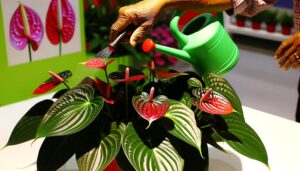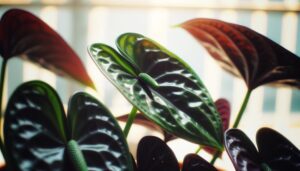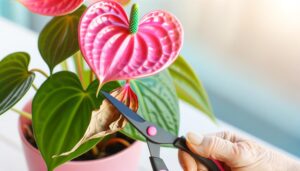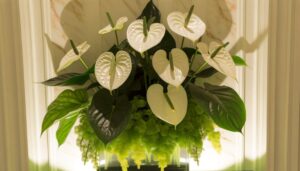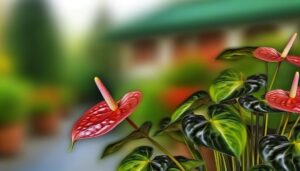Essential Tips for Caring for Your Anthurium Black Mamba
To care for your Anthurium Black Mamba, provide bright, indirect light mimicking its natural understory habitat. Water when the top inch of soil is dry, using distilled or rainwater.
Utilize a well-draining potting mix with orchid bark, perlite, and peat moss, maintaining a slightly acidic pH. Guarantee temperatures between 65-80°F and humidity levels between 70-80%, possibly using a humidifier.
Fertilize bi-weekly in spring and summer with a balanced 20-20-20 N-P-K ratio, and less frequently in autumn and winter. These practices will ensure healthy growth and vibrant foliage; more intricate techniques can further enhance care.
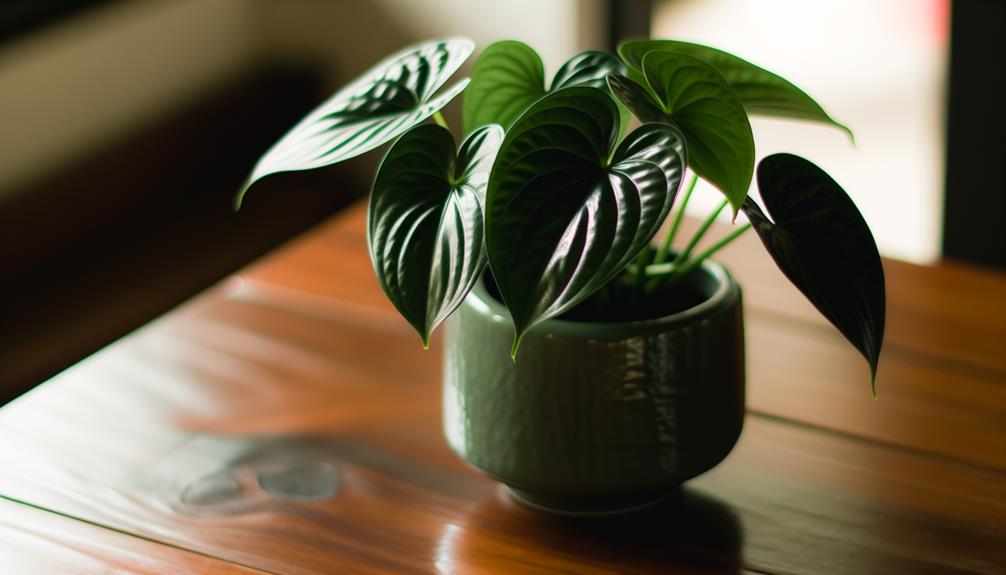
Key Takeaways
- Position the plant in bright, indirect light near an east or north-facing window.
- Water when the top inch of soil is dry, using distilled or rainwater.
- Use a well-draining potting mix of orchid bark, perlite, and peat moss.
- Maintain temperatures between 65-80°F and humidity levels between 70-80%.
- Fertilize with a balanced 20-20-20 N-P-K ratio bi-weekly in spring/summer and monthly in autumn/winter.
Ideal Lighting Conditions
To achieve peak growth and vibrant foliage, Anthurium Black Mamba requires bright, indirect light, as direct sunlight can lead to leaf burn and reduced essentiality. This tropical plant thrives in conditions that mimic its natural understory habitat, where it receives filtered light through the forest canopy.
Positioning the Anthurium near an east or north-facing window provides the ideal light intensity, balancing photosynthetic needs without causing photodamage. If natural light is inadequate, full-spectrum grow lights can be utilized to supplement. It is critical to monitor the plant's response, as insufficient light can result in leggy growth and diminished leaf coloration.
Regularly rotating the plant guarantees even light exposure, promoting uniform development.
Proper Watering Techniques
Ensuring peak hydration for Anthurium Black Mamba involves maintaining a consistent watering schedule that aligns with its moisture requirements, while avoiding waterlogged conditions that can lead to root rot. Accurate watering is critical for this tropical plant, necessitating a delicate balance.
- Frequency: Water the plant once the top inch of soil feels dry to the touch. This typically means watering every 1-2 weeks, depending on environmental conditions.
- Technique: Employ thorough watering until excess water drains out from the bottom of the pot, ensuring even soil moisture without saturation.
- Water Quality: Utilize distilled or rainwater, as tap water may contain fluoride and chlorine, which can accumulate and harm the plant.
These steps help maintain ideal hydration and prevent root diseases.
Soil and Potting Mix
A well-draining, aerated soil mix is crucial for the best growth of Anthurium Black Mamba, guaranteeing sufficient oxygenation and moisture retention without causing root compaction.
A recommended substrate includes a blend of orchid bark, perlite, and peat moss, providing the ideal balance of aeration and moisture. Incorporating horticultural charcoal enhances drainage and reduces the risk of root rot by absorbing excess moisture.
The pH of the soil mix should be slightly acidic, ideally between 5.5 and 6.5, to facilitate nutrient uptake. Avoid dense, heavy soils that hinder aeration and water movement.
Repotting every 1-2 years in fresh mix ensures sustained growth and vigor. Use pots with drainage holes to further prevent waterlogging and promote healthy root development.
Temperature and Humidity
Maintaining ideal temperature and humidity levels is essential for the robust growth and overall health of Anthurium Black Mamba. Native to tropical regions, this plant thrives in conditions mimicking its natural habitat. Aim for a temperature range between 65-80°F (18-27°C) to ensure peak physiological processes. Avoid exposing the plant to temperatures below 55°F (13°C) to prevent stress and potential damage.
Humidity should be maintained between 70-80% to replicate the moisture-rich environment of a rainforest. Use a hygrometer to monitor levels accurately.
To achieve these conditions, consider the following:
- Humidifiers: Utilize to maintain consistent humidity.
- Temperature Control: Use heaters or air conditioning for stable temperatures.
- Mist Regularly: Light misting can boost local humidity.
Following these guidelines will facilitate optimal plant health.
Fertilizing Requirements
To further support the health and growth of Anthurium Black Mamba, appropriate fertilizing practices are paramount. Utilize a balanced, water-soluble fertilizer with an N-P-K ratio of 20-20-20. Fertilize bi-weekly during the growing season (spring and summer), reducing frequency to monthly in autumn and winter. Over-fertilizing can lead to root burn and reduced plant vigor.
| Season | Frequency | Fertilizer Type |
|---|---|---|
| Spring/Summer | Bi-weekly | Water-soluble, 20-20-20 |
| Autumn/Winter | Monthly | Water-soluble, 20-20-20 |
| Year-Round | As needed | Organic alternatives |
Ensure thorough watering after fertilization to prevent salt buildup. Consider organic alternatives like compost or worm castings which provide micronutrients and improve soil structure. Proper fertilization enhances foliage color, promotes flowering, and fortifies overall plant health.
Pruning and Maintenance
Pruning and maintenance of Anthurium Black Mamba necessitate the regular removal of necrotic foliage to prevent disease proliferation and promote peak growth.
Additionally, a consistent inspection and amendment of the soil substrate are imperative to guarantee sufficient aeration and nutrient availability.
These practices, executed with precision, will sustain the plant's health and aesthetic appeal.
Trim Dead Leaves
Effective pruning of Anthurium Black Mamba involves meticulous removal of dead or decaying leaves to promote ideal plant health and aesthetic appearance. This process is critical in preventing the spread of pathogens and enhancing the plant's overall vigor.
To achieve best results, adhere to the following guidelines:
- Sanitize Tools: Use sterilized pruning shears to avoid introducing pathogens. Submerge the blades in a 10% bleach solution or use isopropyl alcohol.
- Identify Affected Leaves: Examine the plant for leaves displaying signs of necrosis, chlorosis, or mechanical damage. These leaves should be pruned first.
- Prune Correctly: Make clean, precise cuts at the base of the petiole, ensuring not to damage the healthy tissue. This promotes quicker healing and reduces stress on the plant.
Regular Soil Check
In addition to pruning, conducting regular soil checks is essential for maintaining the best health and growth of Anthurium Black Mamba. Securing ideal soil conditions involves monitoring pH levels, moisture content, and nutrient balance. Periodically test the soil to detect any deficiencies or imbalances that may impede plant development. Utilize precise instruments such as pH meters and moisture sensors to gather accurate data. Maintaining a slightly acidic to neutral pH range (5.5-6.5) is perfect for Anthurium Black Mamba.
| Parameter | Ideal Range | Tools Needed |
|---|---|---|
| Soil pH | 5.5 – 6.5 | pH Meter |
| Moisture Level | Consistently moist | Moisture Sensor |
| Nutrient Content | Balanced | Soil Test Kit |
| Organic Matter | High | Soil Analysis |
| Soil Texture | Well-draining | Texture Analysis |
Regular checks ensure the plant thrives in excellent conditions.
Pest and Disease Management
Pest and disease management in Anthurium Black Mamba necessitates a thorough understanding of common pathogens and pests such as aphids, spider mites, and root rot fungi. Effective management strategies include:
- Identification and Monitoring: Regularly inspect plants for signs of infestation or disease. Early detection of discolored leaves, webbing, or wilting can prevent widespread damage.
- Cultural Controls: Maintain ideal growing conditions by ensuring proper humidity, adequate ventilation, and avoiding overwatering to reduce the risk of fungal infections.
- Chemical Treatments: Employ insecticidal soaps or neem oil for pest control. For fungal issues, consider fungicides containing copper or sulfur, applied as recommended by the manufacturer.
Implementing these practices fosters a healthier Anthurium Black Mamba, minimizing pest and disease prevalence.
Conclusion
In the symbiotic dance between nature and nurture, the anthurium black mamba thrives as a tribute to meticulous care and environmental harmony. Through adherence to best lighting, precise hydration, suitable soil composition, controlled temperature and humidity, strategic fertilization, and vigilant pest management, this botanical jewel flourishes.
The gardener's role mirrors that of an alchemist, transforming raw elements into a flourishing masterpiece, symbolizing the delicate balance required to maintain and elevate the intrinsic beauty of this exotic plant.

